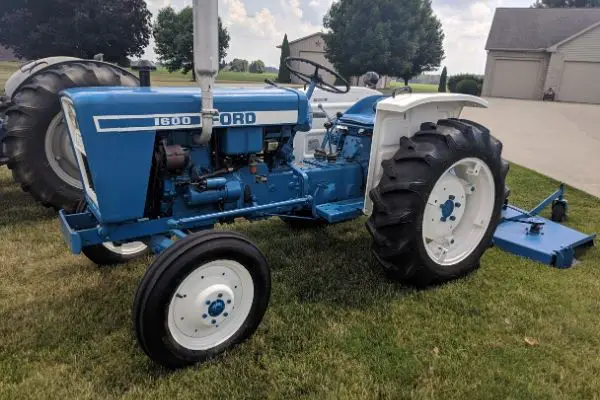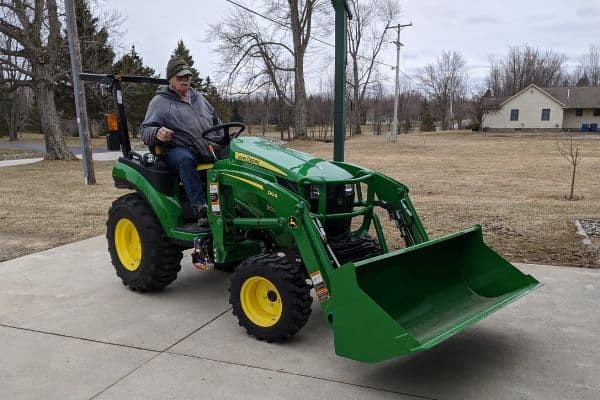Many homesteaders have small diesel tractors that perform snow removal duty or other chores during the cold winter months. I have a Bolens G-152 that I use for blading snow. It has a 3 cylinder Mitsubishi diesel that normally starts pretty well, but every once in a while gives me some trouble.
From those attempts to start my diesel tractor on when the temps dip well below freezing, I’ve learned some tips and tricks for starting those small diesels on cold winter days. Sometimes it’s a fuel issue, sometimes electrical, and sometimes it’s just too damn cold!
Fuel Additive
Diesel fuel has a waxy paraffin that start to form crystals when the temperature drops below freezing. When the temperature drops even lower to around 10-15 degrees Fahrenheit the fuel will actually start to gel which will clog filters and injectors and prevent fuel from flowing.
An additive can be mixed with the diesel fuel to prevent gelling by lower the gel point to an even lower temperature or making the paraffin crystals much smaller so they don’t clog components. Sno-Cat makes a very good fuel conditioner which is the type I use in my Bolens. You can find it here on Amazon.
Winter Mix
Most gas stations in the northern regions switch over to a winter mix diesel during the colder months. There are actually two different types: Winter Blend which is a mixture of #2 Diesel and Kerosene. The other type type is Winterized Diesel which is #2 Diesel pre-mixed with additives from the supplier.
Synthetic Oil
Switching to a full synthetic oil will help with cold weather starting by allowing the engine to turn over easier. This means less drag on the starter which saves on the battery. During cold weather the battery drains much faster when under load.
Glow Plug Maintenance
Unlike a spark plug that creates a small spark to ignite the fuel mixture in a gasoline engine, glow plugs are a heating element that glows red hot to warm up the diesel fuel mixture and allow combustion to happen in the cylinder as the gas are compressed. Over time glow plugs can loss their efficiency and generate less heat than when new. They could even burn out completely.
To check a glow plug, remove it from the engine and use an Ohmmeter to read the resistance from the terminal to the threads. Typically this should be a very low resistance of around 1 Ohm. As glow plugs age this resistance starts to creep up which decreases it’s efficiency. A glow plug with a really high resistance is “burned out” and will not produce any heat all.
You can also visually test a glow plug that has been removed by hooking a 12 volt battery to the terminal end and threads and observe how red the tip of the glow plug glows. Check with your manufacturer for specifics for your tractor and for a maintenance schedule for the ignition system.
There is also some combination of a key switch, push button, and glow plug relay that energizes the glow plugs before starting. If your tractor is having trouble starting than some troubleshooting on this system may be in order.
Fully Charged Battery
Cold weather kills batteries – there’s no doubt about that. The chemical makeup of the battery changes with the amount of charge. A fully charged battery has a much lower freezing point of the electrolyte than a discharged battery does. A discharged battery in cold weather can freeze and damage the plates inside or crack the case ruining the battery.
The best way to prevent this is to keep it charged all the time. Either remove it from the tractor after use and bring into the shop where it’s warm and can be monitored or place a trickle charger on the tractor and keep it plugged in. A Battery Tender brand from Amazon is an excellent way to keep your battery in great shape.
Heavy Battery Cables & Clean Tight Connections
In addition to a full charge, your battery system should include heavy gauge battery cables to the frame or engine block of the tractor and to the starter. Those connections on both ends of those cables should be completely clean and free of corrosion and made up nice and tight to get the best possible connection.
Cranking the engine over isn’t the only draw on the battery. The glow plugs also take quite a bit of current too. For these reasons it is really important to keep your electrical system in tip-top condition. Check the resource page for links to products that help keep your battery in tip-top shape.
Jump Start
At the first sign of the battery starting to die, bring another vehicle over and hook up a set of jumper cables to the tractor battery. If you run the battery down too far while trying to start the tractor, it will have a very long recovery time before you can try again. It is also not good for a conventional battery to be drained all the way down too often. That can shorten the life of the battery by quite a bit.
Magnetic Block Heater
If I don’t keep the block heater on my Bolens when the temp gets below about 20 degrees, she’s probably not going to start. At least not without a lot of fuss. They come in different sizes depending on the size of your engine and what temps your dealing with. I use this Kat’s block heater that you can find on Amazon. I also have a video review of that Kat’s heater on my YouTube channel.
There are a few other options for engine heaters too. There are electric dipstick heaters and blanket heaters, but I have not personally tried these to know how well they work. Any of these heaters of course require and electrical source nearby. You could run a portable generator like this Honda that I use for camping or they also make propane or diesel fired engine heaters. I haven’t really seen any of these for small tractors through. I think they are more for large construction equipment that don’t readily have electricity nearby.
Cover It Up
A tarp or horse blanket alone might help somewhat with keeping the tractor a little warmer between starts, but using a cover in conjunction with an engine heater will help better than either one by itself. The block heater alone really only has enough power to heat the oil in the oil pan and not the entire engine. Once you drape a blanket over the tractor to trap that heat in, then the entire tractor can start to warm up too.
Alternative Source of Warmth
A propane or kerosene salamander or other heater can also be used to warm up your tractor when needed. The trick is to build a tent around the tractor with poles, and a tarp with one end open. Face the heater into the opening and let it heat up. This takes some extreme caution so you don’t start anything on fire. Keep open flames away from anything flammable or combustible and don’t leave it unattended.
I’ve heard of a few other ways the old-timers used to warm up their tractors such as starting a small fire under the engine or using a charcoal grill to put under the engine. Both of these methods seam very dangerous and unpredictable so I don’t recommend either one. I have no doubt someone who has tried these methods has caught their tractor on fire and or burned a building down.
Bonus Tip – Store Her Indoors
Okay this one is obvious, but you can use this as one more reason to put up another barn or storage building to keep that equipment indoors. I’ve even prepared a line for you to say to your significant other to help with the new barn persuasion conversation:
“Honey, I just read online that it is extremely important to keep my tractor indoors with heat and electricity available. Tractors are big investments and must be maintained to uphold their resale value”.
You’re Welcome. 😁






